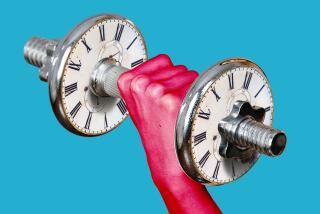Your new exercise Rx from the American College of Sports Medicine: Get out of that chair and move
- Share via
New exercise guidelines released by the American College of Sports Medicine Tuesday may be more detailed than the last, but don’t worry -- the overriding message is that pretty much any kind of activity is better than sitting on the sofa.
Thanks to copious new research the guidelines, last updated in 1998, got an upgrade. The 150-minute or more per week rule for cardio is still there, as is information on strength training. Perhaps the biggest change is the relaxing of stringent exercise guidelines, says Carol Ewing Garber, ACSM vice president and associate professor of movement science at Columbia University. The previous approach emphasized reaching goals for cardio and strength training, a la, “You must do this or you won’t improve your fitness and health,” Garber says. Sure, it would be great for people to reach those goals every week, but that probably won’t happen. “Research now supports the fact that you can do less than what’s recommended and still get benefits. Your weight may stay the same, but your overall health may improve.”
While the guidelines emphasize that exercise beyond the activity from daily living is important, doing things like gardening and walking the dog--even standing occasionally--are still better than sitting in a chair for hours on end.
A new inclusion to the guidelines are recommendations for neuromotor exercise, a fancy way of saying balance and agility training. Those abilities can fade as we age, making it more difficult to recover from falls and we may not notice when balance gets worse. “If some people had to stand on one leg they might be surprised that they can’t do it without some difficulty.”
Missing are specific exercise rules for older people. “It’s not so much your age as it is your fitness level,” says Garber, chairman of the writing group for the position stand. “If you’ve been very inactive you should start exercising at very moderate levels and build up gradually. But you can be 85 years old and fairly active, so you’re not going to be very cautious about how you approach exercise.”
Also touched on in the guidelines is being familiar with the signs and symptoms of heart disease, even for people who are active. And if you haven’t gotten this point by now, don’t be so sedentary. Even people who exercise regularly need to get up and move around if they have sedentary jobs or are inactive for most of the day.
The guidelines also added information on pedometers. While they may not be the most accurate measure of activity, they do offer accountability and help with goal-setting. Says Garber, “These types of monitoring systems help keep people motivated.”
The ACSM doesn’t expect most people to read through the 26-page prescription, but it will be read by trainers and health professionals who will impart the information to clients and patients.
“For the public the simple message is that it really isn’t that complicated, you can pick and choose what you’d like to do. ... For adults, the main objective for exercise for most of us is to be healthy and maintain our ability to do the activities of life we enjoy,” Garber adds. “Most of us are not trying to run a marathon.”






